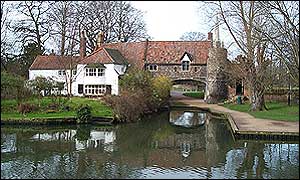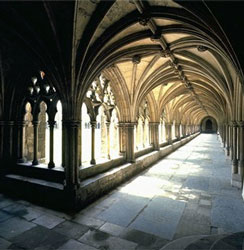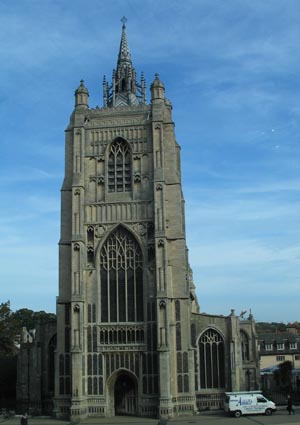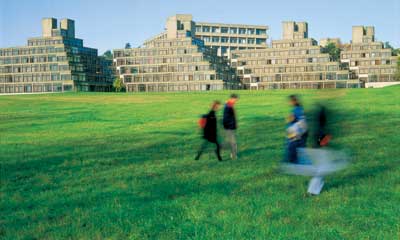 At the moment, unless something strange has happened, I am in Norwich, England. Norwich was the second-largest city in England at one point during the Middle Ages, but was subsequently passed in size and importance by many other cities. This may be one reason why Norwich is so beautiful today: the all-consuming drives of industry and modernity didn’t hit Norwich as hard as elsewhere, and so much of the city is old.
At the moment, unless something strange has happened, I am in Norwich, England. Norwich was the second-largest city in England at one point during the Middle Ages, but was subsequently passed in size and importance by many other cities. This may be one reason why Norwich is so beautiful today: the all-consuming drives of industry and modernity didn’t hit Norwich as hard as elsewhere, and so much of the city is old.
 There are many medieval bits of Norwich, including its layout. I spent a year at the University of East Anglia (which is in Norwich, though off to the side a bit), where I studied creative writing (and Jane Austen and Restoration comedy and whatnot). I went into town nearly every weekend, and came to learn that even if you know the location of point A (e.g. the market), and the location of point B (e.g. the cathedral, or that neat little flea market-y shop that sold Georgette Heyer paperbacks for 20p), you can’t just head in the correct direction and actually arrive there. No, all the streets twist and curve and wind, and you’ll find yourself somewhere else entirely. Quite likely at Norwich Castle.
There are many medieval bits of Norwich, including its layout. I spent a year at the University of East Anglia (which is in Norwich, though off to the side a bit), where I studied creative writing (and Jane Austen and Restoration comedy and whatnot). I went into town nearly every weekend, and came to learn that even if you know the location of point A (e.g. the market), and the location of point B (e.g. the cathedral, or that neat little flea market-y shop that sold Georgette Heyer paperbacks for 20p), you can’t just head in the correct direction and actually arrive there. No, all the streets twist and curve and wind, and you’ll find yourself somewhere else entirely. Quite likely at Norwich Castle.
 Cubical Norwich Castle (built during the time of William the Conqueror) sits atop a large hill, and all of central Norwich circles the castle. So do the buses. If you need to take a bus somewhere, chances are it will stop somewhere in the ring around the castle. (This is nothing like ring around the collar.) There are many medieval buildings in Norwich, and a lot of Georgian ones, too. Not much Victorian, though. (Which is either a good thing or a bad thing, depending on your taste in architecture.)
Cubical Norwich Castle (built during the time of William the Conqueror) sits atop a large hill, and all of central Norwich circles the castle. So do the buses. If you need to take a bus somewhere, chances are it will stop somewhere in the ring around the castle. (This is nothing like ring around the collar.) There are many medieval buildings in Norwich, and a lot of Georgian ones, too. Not much Victorian, though. (Which is either a good thing or a bad thing, depending on your taste in architecture.)
 It is said that at one time, Norwich had a church for every week of the year…and a pub for every day of the year. Many of the churches are still standing, though decreased attendance has driven preservation committees to find alternate uses for some of them. Now, you can find antique fairs and museums inside old churches! Many of them are made of flint, the shiny, hard, black local stone. (Though this church isn’t flint! This is St. Peter Mancroft, built in 1455, and located right next to the market in the city centre.)
It is said that at one time, Norwich had a church for every week of the year…and a pub for every day of the year. Many of the churches are still standing, though decreased attendance has driven preservation committees to find alternate uses for some of them. Now, you can find antique fairs and museums inside old churches! Many of them are made of flint, the shiny, hard, black local stone. (Though this church isn’t flint! This is St. Peter Mancroft, built in 1455, and located right next to the market in the city centre.)
 The University of East Anglia is one of Britain’s numerous newer universities. This means, unfortunately, that it is modern. I do not much like modern. As far as I can tell, modern buildings win awards from architects, and drive the people who actually have to live in them absolutely batty. (I have lived in an ugly building or two in my time. I have also lived in much nicer-looking buildings. I strongly prefer the latter.) The odd building pictured here is a dormitory at the University of East Anglia. This, believe it or not, is one of the prettier buildings on campus. (I was not lucky enough to be housed in one of these. My dorm was much worse. And much less interesting.)
The University of East Anglia is one of Britain’s numerous newer universities. This means, unfortunately, that it is modern. I do not much like modern. As far as I can tell, modern buildings win awards from architects, and drive the people who actually have to live in them absolutely batty. (I have lived in an ugly building or two in my time. I have also lived in much nicer-looking buildings. I strongly prefer the latter.) The odd building pictured here is a dormitory at the University of East Anglia. This, believe it or not, is one of the prettier buildings on campus. (I was not lucky enough to be housed in one of these. My dorm was much worse. And much less interesting.)
Cara
Cara King, www.caraking.com

Cara:
I think you are as fond of parentheses as you are of exclamation points!! (those were for you).
Norwich sounds lovely. I hope you are having a fabulous time.
I’m loving all the pictures in the various entries from England. Not sure if that’s something I’ll ever be able to do in live, actually go there, but hey, I can live vicariously through all of you! 🙂 Anyway, the picture that definitely did stick out was the university. At first when I was reading down, and I wasn’t focused on it, I thought you added a picture from Mexico, it looked like the Mayan Temples!! Yep, I’m not always fond of modern architecture. I’m in no way any expert at it, but I definitely know what I don’t like!! LOL 🙂
Lois
Hope you’re having a marvelous time, Cara! The pics are lovely–even the wierd architecture is at least wierd and interesting:)
Hope you can find some of those 20p Georgette Heyers while you’re there!
Cheers!
These pictures are great, Cara! I’m so jealous of your travels. 🙂
A belated hello! again from England!
Megan, I definitely like parentheses a lot, as well as exclamation points. The exclamation points show people that I’m nice, so they will like me. The parentheses express what my brain really does, which is always run off on little tangents all the time.
I have reduced the use of both exclamation points and parentheses in my fiction writing, though I do still use both! (Someone critiquing my first ms once told me that I was not allowed to use parentheses in fiction. Hah! I figure, if I sell that book, and the editor wants me to take them out, perhaps I will, but I won’t for anyone else!) 🙂
Cara
Lois, I think the university actually refers to those pyramid-like buildings as ziggurats! 🙂
And I’m glad everyone likes the pics! I will have many more when I return…
Cara
Cara, I tend to dislike a lot of modern architecture too, though sometimes I like it. I haven’t quite put my finger on what makes the difference for me. I think I find harsh angles off-putting somehow.
First, I want to clarify. I said that I use exclamation points to show that I am nice! This, of course, makes no sense. I use smileys to show that I am nice. I use exclamation points to lead people to think that I am youthful. 🙂
Elena, I don’t hate all modern architecture either. But both in the US and the UK there were an awful lot of postwar and 50’s and 60’s buildings that were just dreary and ugly and generally horrid. Tall council housing in the UK, ‘the projects’ in the US — yuck! And huge slabs of concrete, grey grey gray with no relief. The Barbican. That sort of thing. Not my style. 🙂
Some of the more recent stuff, I sort of like. 🙂
Cara (a.k.a. smiley king)
I think some of the Docklands development in London is quite nice, even though it’s modern. 🙂
Todd-who-uses-smileys-too